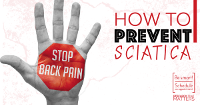
LAVACA COUNTY
CHIROPRACTIC
How to Prevent Sciatica
 Bottom Line: It’s easy to understand how lifting a heavy object at work could injure your back, pinch a nerve and cause sciatica. But, surprisingly, research has shown that too much sitting may be the number one reason for sciatica, not to mention the worst thing for your back. When you spend hours per day sitting down, the muscles in your buttocks and legs become tight and the muscles that support your low back start to deteriorate or atrophy. Without strong stabilizing muscles to support your discs and nerves, it’s no surprise that you are more likely to injure your back if you spend a lot of time sitting.
Bottom Line: It’s easy to understand how lifting a heavy object at work could injure your back, pinch a nerve and cause sciatica. But, surprisingly, research has shown that too much sitting may be the number one reason for sciatica, not to mention the worst thing for your back. When you spend hours per day sitting down, the muscles in your buttocks and legs become tight and the muscles that support your low back start to deteriorate or atrophy. Without strong stabilizing muscles to support your discs and nerves, it’s no surprise that you are more likely to injure your back if you spend a lot of time sitting.
Why it Matters: Fortunately, preventing sciatica may be easier than you think. New research indicates that consistent exercise can stop, or even reverse, the effects of too much sitting. Just thirty minutes of exercise each day can help strengthen the supporting muscles around your spinal column and help prevent future episodes of sciatica. What about chiropractic care? The top research journal SPINE found that maintained chiropractic care can actually prevent future episodes of low back pain. Getting well and staying well with chiropractic sounds like a smart decision. Here are some take away points:
- Chiropractors can help evaluate, detect, treat, and prevent future episodes of low back pain
- Exercise daily to help strengthen the core muscles that support your spinal column
- Stretch before and after activity to improve your flexibility and reduce your chances of injury
Next Steps: Take action by setting a daily schedule of exercise. If time is tight, take a few minutes every hour at work to walk around the office. Remember, starting small is better than not starting at all. And, as days become weeks, months, and years; the exercise that you do now will pay huge dividends down the road to keep you happy, healthy, and pain-free.
Science Source:
Does Maintained Spinal Manipulation Therapy for Chronic Nonspecific Low Back Pain Result in Better Long-Term Outcome? SPINE. 2011
by Christopher Freytag, D.C.
Previous Post: What Causes Sciatica?
Next Post: How to Keep Your Spinal Discs Healthy